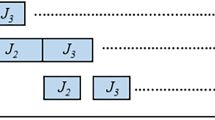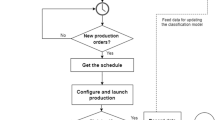Abstract
This paper considers single machine scheduling problems where the processing time of a job increases as a function of its position in the sequence. In this model, the later a given job is scheduled in the sequence, the longer its processing time. It is shown that the optimal schedule may be very different from that of the classical version of the problem. We introduce polynomial solutions for the makespan minimization problem, the sum of completion times minimization problem and the sum of earliness penalties minimization problem. For two resource constrained problems, based on the analysis of the problems, the optimal resource allocation methods are presented, respectively.
Similar content being viewed by others
References
A. Bachman and A. Janiak,Scheduling jobs with position-dependent processing times, J. Oper. Res. Soc.55 (2004), 257–264.
D. Biskup,Single-machine scheduling with learning considerations, Eur. J. Oper. Res.115 (1999), 173–178.
T. C. E. Cheng and A. Janiak,Resource optimal control in some single machine scheduling problem, IEEE Trans. Automat. Contr.39 (1994), 1243–1246.
A. Janiak,Time-optimal control in a single machine problem with resource constraints, Automatica22 (1986), 745–747.
J. R. Jackson,Scheduling a production line to minimize maximum tardiness, Research Report 43, Management Science Research Project, University of California, Los Angeles 1955.
W-C. Lee, C-C. Wu and H-J. Sung,A bi-criterion single-machine scheduling problem with learning considerations, Acta. Inform.40 (2004), 303–315.
J. M. Moore,An n job one machine sequencing algorithm for minimizing the number of late jobs, Manage. Sci.15 (1968), 102–109.
G. Mosheiov,Scheduling problems with a learning effect, Eur. J. Oper. Res.132 (2001), 687–693.
G. Mosheiov,Parallel machine scheduling with a learning effect, J. Oper. Res. Soc.52 (2001), 1165–1169.
G. Mosheiov and B. Sidney,Scheduling with general job-dependent learning curves, Eur. J. Oper. Res.147 (2003), 665–670.
G. Mosheiov and B. Sidney,Note on scheduling with general learning curves to minimize the number of tardy jobs, J. Oper. Res. Soc.56 (2005), 110–112.
J-B. Wang,Flow shop scheduling jobs with position-dependent processing times, J. Appl. Math. & Computing18 (2005), 383–391.
J-B. Wang,No-wait or no-idle permutation flowshop scheduling with dominating machines, J. Appl. Math. & Computing17 (2005), 419–432.
Author information
Authors and Affiliations
Corresponding author
Rights and permissions
About this article
Cite this article
Zhao, CL., Tang, HY. Single-machine scheduling problems with an aging effect. J. Appl. Math. Comput. 25, 305–314 (2007). https://doi.org/10.1007/BF02832355
Received:
Revised:
Issue Date:
DOI: https://doi.org/10.1007/BF02832355




